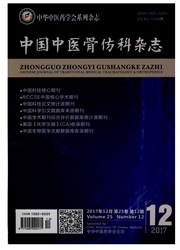

 中文摘要:
中文摘要:
目的:评价针灸治疗脊髓损伤后神经源性膀胱的疗效和安全性,为临床提供指导和依据。方法:计算机检索PubMed,EMBASE,Cochrane临床对照试验注册资料库,中国知网数据库,万方数据库,维普数据库,中国生物医学文献数据库,检索时间自建库至2016年7月,获得与针灸治疗脊髓损伤后神经源性膀胱相关的随机对照试验,应用RevMan5.3软件进行数据分析,根据纳入研究间的异质性选择相应的效应模型,无法进行数据合并时采用描述性分析。结果:1)与对照组相比,针灸治疗组可显著减少膀胱残留尿量(尿流动力学检测亚组:MD=-36.91,95%CI=-41.08~-32.75,P〈0.000 01.B超检测亚组:MD=-27.07,95%CI=-34.48~-19.66,P〈0.000 01.导尿法亚组:MD=-25.6,95%CI=-47.24~-3.96,P=0.02)。2)与对照组相比,针灸治疗组可显著增加膀胱最大容量(尿流动力学检测亚组:MD=53.38,95%CI=43.48~63.28,P〈0.000 01.B超检测亚组:MD=51.99,95%CI=36.91~67.08,P〈0.000 01;导尿法亚组:MD=36.42,95%CI=-41.28~114.12,P=0.36)。3)与对照组相比,针灸治疗组可增大尿道闭合压(MD=7.04,95%CI=4.92~9.16,P〈0.000 1)。4)与对照组相比,针灸治疗组可改善膀胱顺应性(MD=0.89,95%CI=0.53~1.25,P〈0.000 1)。5)与对照组相比,针灸治疗组日平均尿失禁次数显著减少(MD=-1.89,95%CI=-2.15~-1.63,P〈0.000 1)。6)与对照组相比,针灸治疗组日平均排尿量显著增加(MD=61.37,95%CI=49.57~73.18,P〈0.000 1)。7)与对照组相比,针灸治疗组的治疗有效率显著提高(RR=1.48,95%CI=1.31~1.68,P〈0.000 1)。8)针灸治疗组不良事件发生率与对照组相比差异无统计学意义(RR=0.37,95%CI=0.1~1.36,P=0.13)。结论:针灸治疗单独应用或针灸治疗作为辅助治疗,联合其他治疗方法治疗脊髓损伤后神经源性膀胱具有一定的有效性和安全性,可减少膀胱残留尿量、日平均尿失禁次数,增大膀胱最大容量、尿道闭合压和日平均?
 英文摘要:
英文摘要:
Objective:To evaluate the effect and safety of acupuncture for neurogenic bladder after spinal cord injury.Methods:PubMed,EMBASE,Cochrane Central Register of Controlled Trials(CENTRAL),China National Knowledge Infrastructure(CNKI)database,Wanfang database,Chinese Science and Technology Periodical(VIP)database and SinoMed database were retrieved from their inception to July 2016 by computer to obtain relative randomized controlled trials(RCT)about acupuncture for neurogenic bladder after spinal cord injury.RevMan V5.3software was used to analyze data and effect model was selected in accordance with heterogeneity.Descriptive analysis was used when data consolidation was not possible. Results:1)Compared with controlled group,the residual urine volume was significantly reduced in acupuncture group(Urodynamic determination subgroup:MD=-36.91,95%CI=-41.08~-32.75,P〈0.000 01;B-ultrasound examination subgroup:MD=-27.07,95%CI=-34.48~-19.66,P〈0.000 01;Catheterization group:MD=-25.6,95%CI=-47.24~-3.96,P=0.02).2)Compared with controlled group,the maximum bladder capacity was significantly enlarged in acupuncture group(Urodynamic determination subgroup:MD=53.38,95%CI=43.48~63.28,P〈0.000 01;B-ultrasound examination subgroup:MD=51.99,95%CI=36.91~67.08,P〈0.000 01;Catheterization group:MD=36.42,95%CI=-41.28~114.12,P=0.36).3)Compared with controlled group,the urethral closure pressure was significantly increased in acupuncture group(MD=7.04,95%CI=4.92~9.16,P〈0.0001).4)Compared with controlled group,the bladder compliance was significantly ameliorated in acupuncture group(MD=0.89,95%CI=0.53~1.25,P〈0.000 1).5)Compared with controlled group,the daily mean urinary incontinence was significantly decreased in acupuncture group(MD=-1.89,95%CI=-2.15~-1.63,P〈0.000 1).6)Compared with controlled group,the daily mean micturition volume was significantly increased in acupuncture group(MD=61.37,95%CI=49.57~73.18,P〈0.000 1).7)Compared with controlled group,the
 同期刊论文项目
同期刊论文项目
 同项目期刊论文
同项目期刊论文
 期刊信息
期刊信息
